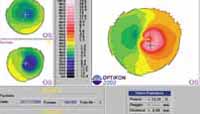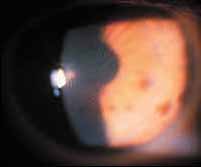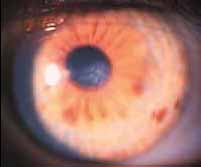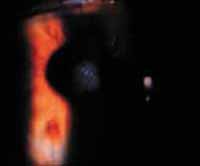Non-specific diffuse interstitial keratitis demands attention
Prompt recognition of non-specific diffuse interstitial keratitis is mandatory.
ROME — Speedy identification and immediate treatment of non-specific diffuse interstitial keratitis (NSDISK) are the keys to interrupting the process and achieving acceptable postoperative visual acuity, according to refractive surgeon, Paolo Michieletto, MD.
Dr. Michieletto described the prevalence, the clinical course, the treatment and the final outcomes of 19 patients who experienced non-specific NSDISK following laser in situ keratomileusis (LASIK). “The pathogenesis of diffuse lamellar keratitis is toxic, and the etiology is multifactorial,” said Dr. Michieletto. Possible causes, he said, include meibomian secretion, epithelial abrasion, material debris from the microkeratome, debris from the microkeratome blades, bacterial endotoxin and thermal effects.
Grading system
“To discuss SOS treatment modalities, a staging classification for NSDISK is crucial,” said Dr. Michieletto. A grade 1 case of NSDISK is the least serious. Patients are asymptomatic, and their vision and refraction are unaffected. “The condition may be recognized anywhere from day 1 to day 7 postop,” said Dr. Michieletto. “It may be an interface infiltration that may be diffuse or just peripheral, and it usually results within 1 month of surgery,” he said. His therapy for grade 1 NSDISK is instillation of high-penetration steroids every hour during waking hours.
Grade 2 NSDISK is observed more frequently, according to Dr. Michieletto. “Patients are symptomatic, and their vision is diminished,” he said. “It appears as moderate haze that is denser centrally.” His treatment of grade 2 NSDISK comprises topical steroids and antibiotics, as well as a subconjunctival injection of methylprednisolone. “Improvement begins from the corneal periphery throughout the center,” he said. If improvement is not observed in 2 days, he lifts the LASIK flap and flushes out the interface, in an attempt to avoid the meibomian secretion and possible melting that comes with a grade 3 NSDISK.
Grade 3 is less common, but more severe. “Grade 3 is the conclusion of grade 2. It is observed at day 4 or 5,” Dr. Michieletto said. When a case progresses to this level, a significant amount of reduction of visual acuity should be expected, according to Dr. Michieletto. “The eye is white, and the central infiltrate appears as an active stromal infection, whereas a grade 4 haze is limited to the interface,” he said. “The stromal bed is partly involved. Striae are present directed towards the infiltrate.”
Therapy for a grade 3 NSDISK involves lifting the LASIK flap and irrigating with steroids and antibiotics, as well as a 5 mµ phototherapeutic keratectomy (PTK) procedure in the stromal bed and the internal side of the flap.
The clinical strategy necessary to arrest progression of an NSDISK, according to Dr. Michieletto, involves recognition of its general appearance on postop day 1, identification of the stage of inflammation and clinical follow-up every 24 hours with visual acuity testing, biomicroscopy, topography and pachymetry, preferably of the non-contact variety.
If improvement is not seen within 24 to 48 hours, Dr. Michieletto lifts the flap and irrigates the stromal bed with balanced salt solution, dexamethasone and ofloxacin in an attempt to avoid a Grade 3. “In fact,” he said, “early flap re-lift is paramount to a favorable outcome.”
“In our experience, we unfortunately had 25 cases of Sands of the Sahara syndrome, but 85% of them resolved with just medical therapy,” Dr. Michieletto said. “We noticed that in the remaining cases, those who underwent a re-lift showed reduced melting, lower active keratocyte production with subsequent increase of corneal thickness and curvature, and more frequent folds of micro-striae for flap reposition.”
Prevention
To prevent NSDISK, Dr. Michieletto recommends that surgeons carefully assess their technique, employ precise microkeratome cleaning and periodically service the microkeratome. “I use one blade for each eye, carefully inspect the blade at the microscope, wash the blade with saline solution before assembly, check the engine tension and look for oil leakage,” said Dr. Michieletto.
Dr. Michieletto described the results of 19 NSDISK patients on whom he had almost 6 months of follow-up. Of those patients, 18 had bilateral LASIK, and nine had bilateral NSDISK. In all cases, diagnosis was made on the first postop day, and aggressive local therapy was immediately started. In two bilateral cases, the flap was re-lifted, and copious irrigation was performed with balanced salt solution, corticosteroids and antibiotics. All grade 1 and 2 cases resolved in 15 days on medical therapy. “In these eyes,” he said, “the refractive outcome was as expected.” In grade 3 NSDISK eyes, corneal thinning was observed. More thinning occurred in the grade 3 case that was not re-lifted. No best-corrected visual acuity was lost in the eyes that had their flaps re-lifted and irrigated; whereas four lines of vision were lost in the case of grade 3 NSDISK where the flap was not re-lifted.
 |
 |
| 1 year postop | 8 days vs. 1 year postop |
 |
 |
| One day postop. | Eight days postop. |
 |
 |
| Forty-five days postop. | Three months postop. |
 |
|
| One year postop. | |
For Your Information:
- Paolo Michieletto, MD, can be reached at Via Banchi Nuovi 3, Rome, Italy 00186; +(39) 06-686-1515; fax: +(39) 06-642-013542; e-mail: michieye@tin.it.
